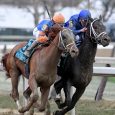
Hambletonian winner Perfect Spirit wasn’t eligible to run in the Yonkers Trot.
Yonkers Raceway had a spectacular racing card last Saturday, as the Yonkers Trot, Messenger Stakes, Lady Maud and Hudson Trot were contested. Those races offered a combined total of over $1.2 million in purses. In the Messenger, Downbytheseaside was tested and prevailed in a thrilling finish; and in the Yonkers Trot, Top Flight Angel was able to get past Yes Mickey in the final stages, making for two thrillers in a row.
But how many fans know that both the Yonkers Trot and Messenger Stakes are the second jewels of the trotting and pacing Triple Crown respectively? If you ask the casual sports fan to name the three Triple Crown races for thoroughbreds, many can come up with at least two if not all three.
As usual, there wasn’t much hype for these “second jewels”.
Yonkers did their usual press releases courtesy of their witty publicity director Frank Drucker, but unless you visited harness racing websites, you were out of luck when it came to getting information.
Why is that? Why isn’t there more coverage of these events? Are newspapers so strapped for space that they will not run a few words before and after the races? Are they too short staffed to have someone take a press release, turn it into a capsule and inform the readers?
What about the harness racing industry?
Many tracks are buoyed by casino revenues, yet most of the additional monies are used for purses, something the horsemen all want, expect and demand. They can’t be blamed for this — they work hard, most toiling seven days a week, and they want to be compensated for that work. But why not use a portion of that revenue to better market the sport?
When there are commercials for racinos on TV, radio and the internet, they tout everything but the racing. The old saying “you gotta spend money to make money” rings true here.
The other disappointing part of Saturday is how the Triple Crown is perceived by those in the sport. In thoroughbred racing, the Kentucky Derby winner is feted.
Derby champs are assigned barn 40 at Pimlico in anticipation of their Preakness run. The buzz is palpable — can the Derby winner capture the middle jewel and head to New York with a Triple Crown on the line? There is a drop-off in TV ratings from the Kentucky Derby, of course, but even those that skip watching the Preakness are monitoring it. If the Derby horse wins, they come back to watch the Belmont Stakes. We saw that right before our eyes when American Pharoah ran for and became the 12th horse to win the thoroughbred Triple Crown.
In the thoroughbred game, you can nominate your horse for the Triple Crown for a nominal, $600 fee when they are two years old. This makes them eligible for all three races — Derby, Preakness and Belmont.
In harness racing, everything is its own separate entity. The Hambletonian winner, Perfect Spirit, wasn’t eligible to run in the Yonkers Trot. Does this make sense? There is no guarantee that the connections would send him there, but we know if they’re not eligible, they’re likely not going.

Ray Schnittker, trainer of Huntsville, was adamant about not running in the third jewel of the Pacing Triple Crown.
Huntsville won both the Meadowlands Pace and the Cane Pace — the latter being the first jewel of the pacing Triple Crown. After his Cane win, trainer Ray Schnittker was emphatic, declaring boldly that his horse was not going to contest the Little Brown Jug, the third and by far the best-known of the three events for pacers. In fact, Schnittker didn’t keep Huntsville eligible for the race that routinely draws 40,000 fans to the Delaware County Fair in Ohio.
Again, is this good for the sport?
In addition to the Triple Crown races, thoroughbred racing has the Breeder’s Cup in early November, giving it four major events on the sports calendar. Because harness racing has pacers and trotters, they actually have seven events to showcase, culminating with the Breeders Crown races at the end of October.
This provides a perfect opportunity to put on display the best the sport of harness racing has to offer, but, because of each race’s independent nature, that doesn’t happen. Could you imagine Kentucky Derby winner Always Dreaming missing the Preakness because he wasn’t eligible. In harness racing, that happens.
If you want to grow the sport, the effort to do so has to be made.


